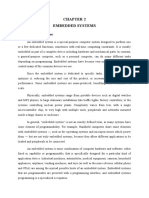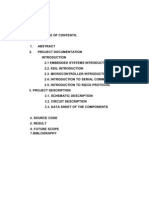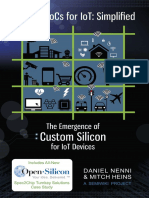Embedded Systems 2
Embedded Systems 2
Uploaded by
Ankit SharmaCopyright:
Available Formats
Embedded Systems 2
Embedded Systems 2
Uploaded by
Ankit SharmaCopyright
Available Formats
Share this document
Did you find this document useful?
Is this content inappropriate?
Copyright:
Available Formats
Embedded Systems 2
Embedded Systems 2
Uploaded by
Ankit SharmaCopyright:
Available Formats
http://www.btechstudent.com http://www.1000projects.com http://www.chetanasprojects.
com
EMBEDDED SYSTEMS
An Embedded system is a special-purpose system in which the computer is completely encapsulated by the device it controls, such as a personal computer, an embedded system performs pre-defined tasks, usually with very specific requirements.
Examples of Embedded systems:
Automatic teller machines (ATMs) Avionics, such as inertial guidance systems, flight control hardware/software and other integrated systems in aircraft and missiles Cellular telephones and telephone switches Computer equipment such as routers and printers Engine controllers and antilock brake controllers for automobiles
The Apollo Guidance Computer, the first recognizably modern embedded system. The first recognizably modern embedded system was the Apollo Guidance Computer, developed by Charles Stark Draper at the MIT Instrumentation Laboratory. Each flight to the moon had two. They ran the inertial guidance systems of both the command module and LEM. The first mass-produced embedded system was the Autonetics D-17 guidance computer for the Minuteman missile, released in 1961. It was built from discrete transistor logic and had a hard disk for main memory.
http://www.btechstudent.com http://www.1000projects.com http://www.chetanasprojects.com
http://www.btechstudent.com http://www.1000projects.com http://www.chetanasprojects.com When the Minuteman II went into production in 1966, the D-17 was replaced with a new computer that was the first high-volume use of integrated circuits. There has also been an enormous rise in processing power and functionality. For example the first microprocessor was the Intel 4004, which found its way into calculators and other small systems, but required external memory and support chips. External system components had been integrated into the same chip as the processor, resulting in integrated circuits called microcontrollers, and widespread use of embedded systems became feasible.
CHARACTERISTICS:
Embedded systems are designed to do some specific task, rather than be a generalpurpose computer for multiple tasks. Some also have real-time performance constraints that must be met, for reason such as safety and usability; others may have low or no performance requirements, allowing the system hardware to be simplified to reduce costs. Users typically select hardware that is just good enough to implement the necessary functions. For example, a digital set-top box for satellite television has to process large amounts of data every second, but most of the processing is done by custom integrated circuits. The embedded CPU "sets up" this process, and displays menu graphics, etc. for the set-top's look and feel. For low-volume or prototype embedded systems, personal computer hardware can be used, by limiting the programs or by replacing the operating system with a real-time operating system. The software written for embedded systems is often called firmware, and is stored in ROM or Flash memory chips rather than a disk drive. It often runs with limited hardware resources: small or no keyboard, screen, and little RAM memory. Embedded systems reside in machines that are expected to run continuously for years without errors, and in some cases recover by themselves if an error occurs. Therefore the Software is usually developed and tested more carefully than that for Personal
http://www.btechstudent.com http://www.1000projects.com http://www.chetanasprojects.com
http://www.btechstudent.com http://www.1000projects.com http://www.chetanasprojects.com computers, and unreliable mechanical moving parts such as Disk drives, switches or buttons are avoided.
User interfaces:
Embedded systems range from no user interface at all - dedicated only to one task - to full user Interfaces similar to desktop operating systems in devices such as PDAs. One approach widely used in embedded systems without sophisticated displays, uses a few buttons to control a menu system, with some for movement and some for adjustments. On such devices simple, obvious, and low-cost approaches like redyellow-green lights are common. The advantage of this system is that the meaning of the buttons can change with the screen, and selection can be very close to the natural behavior of pointing at what's desired.
CPU Platform:
There are many different CPU architectures used in embedded designs such as ARM, MIPS, Coldfire/68k, PowerPC, X86, PIC, 8051, Atmel AVR, Renesas H8, SH, V850, FR-V, M32R etc. PC/104 is a typical base for small, low-volume embedded and ruggedized system design. These often use DOS, Linux, or an embedded real-time operating system such as QNX or Inferno.
Tools:
As for other software, embedded system designers use compilers, assemblers, and debuggers to develop embedded system software. However, they may also use some more specific tools:
http://www.btechstudent.com http://www.1000projects.com http://www.chetanasprojects.com
http://www.btechstudent.com http://www.1000projects.com http://www.chetanasprojects.com An in-circuit emulator (ICE) is a hardware device that replaces or plugs into the microprocessor, and provides facilities to quickly load and debug experimental code in the system.
Utilities to add a checksum or CRC to a program, so the embedded system can check if the program is valid For systems using digital signal processing, developers may use a math workbench such as MathCAD or Mathematica to simulate the mathematics. Custom compilers and linkers may be used to improve optimisation for the particular hardware.
Software tools can come from several sources:
Software companies that specialize in the embedded market Ported from the GNU software development tools (see cross compiler) Sometimes, development tools for a personal computer can be used if the embedded processor is a close relative to a common PC processor
Debugging:
Embedded Debugging may be performed at different levels, depending on the facilities available, ranging from assembly- or source-level debugging with an incircuit emulator, to output from serial debug ports, to an emulated environment running on a personal computer. As the complexity of embedded systems grows, higher level tools and operating systems are migrating into machinery where it makes sense. For example, cell phones, personal digital assistants and other consumer computers often need significant software that is purchased or provided by a person other than the manufacturer of the electronicsMost such open environments have a reference design that runs on a PC. Much of the software for such systems can be developed on a conventional PC. However, the porting of the open environment to the specialized electronics, and the
http://www.btechstudent.com http://www.1000projects.com http://www.chetanasprojects.com
http://www.btechstudent.com http://www.1000projects.com http://www.chetanasprojects.com development of the device drivers for the electronics are usually still the responsibility of a classic embedded software engineer.
Start-up:
All embedded systems have start-up code. Usually it sets up the electronics, runs a self-test, and then starts the application code. The startup process is commonly designed to be short, such as less than a tenth of a second, though this may depend on the application.
Self-Test:
Most embedded systems have some degree or amount of built-in self-test. In safetycritical systems, they are also run periodically or continuously. There are several basic types: 1. Testing the computer: CPU, RAM, and program memory. These often run once at power-up. 2. Tests of peripherals: These simulate inputs and read-back or measure outputs. 3. Tests of power supply, including batteries or other backup. 4. Consumables tests: These measure what a system uses up, and warn when the quantities are low, for example a fuel gauge in a car, or chemical levels in a medical system.
Reliability regimes:
The system cannot safely be shut down for repair, or it is too inaccessible to repair. Generally, the embedded system tests subsystems, and switches redundant spares on line. Instead of hardware substitution, it may use software "limp modes" that provide partial function. The system must be kept running for safety reasons. Like the above, but "limp modes" are less tolerable. Often backups are selected by an operator.
http://www.btechstudent.com http://www.1000projects.com http://www.chetanasprojects.com
http://www.btechstudent.com http://www.1000projects.com http://www.chetanasprojects.com Examples include aircraft navigation, reactor control systems, safety-critical chemical factory controls, train signals, engines on single-engine aircraft. The system cannot be operated when it is unsafe. Similarly, perhaps a system cannot be operated when it would lose too much money. (Medical equipment, aircraft equipment with hot spares, such as engines, chemical factory controls,
Embedded software architectures:
Simple control loop Nonpreemptive multitasking Preemptive multitasking
Simple control loop:
the software simply has a loop. The loop calls subroutines, each of which manages a part of the hardware or software. A common model for this kind of design is a state machine, which identifies a set of states that the system can be in and how it changes between them, with the goal of providing tightly defined system behaviour. This system's strength is its simplicity, and on small pieces of software the loop is usually so fast that nobody cares that its timing is not predictable. It is common on small devices with a stand-alone microcontroller dedicated to a simple task.
Preemptive multitasking:
This is the level at which the system is generally considered to have an "operating system", and introduces all the complexities of managing multiple tasks running seemingly at the same time.
http://www.btechstudent.com http://www.1000projects.com http://www.chetanasprojects.com
http://www.btechstudent.com http://www.1000projects.com http://www.chetanasprojects.com Any piece of task code can damage the data of another task; they must be precisely separated. Access to shared data must be controlled by some synchronization strategy, such as message queues, semaphores or a non-blocking synchronization scheme. Because of these complexities, it is common for organizations to buy a real-time operating system, allowing the application programmers to concentrate on device functionality rather than operating system services.
Non preemptive multitasking:
A non preemptive multitasking system is very similar to the above, except that the loop is hidden in an API. The programmer defines a series of tasks, and each task gets its own environment to "run" in. Then, when a task is idle, it calls an idle routine (usually called "pause", "wait", "yield", etc.). An architecture with similar properties is to have an event queue, and have a loop that processes the events one at a time. The advantages and disadvantages are very similar to the control loop, except that adding new software is easier, by simply writing a new task, or adding to the queueinterpreter.
Exotic custom operating systems:
Since these systems are often developed by programmers without real-time expertise, horror stories are common. However, some techniques are widely known and used by experienced implementors, but rarely taught in universities. For example, many operating systems use queues to serialize and prioritize events.
http://www.btechstudent.com http://www.1000projects.com http://www.chetanasprojects.com
http://www.btechstudent.com http://www.1000projects.com http://www.chetanasprojects.com
CONCLUSION:
An embedded system is a special type of system with some device controls,
and it is integrated with in a single chip and acts as a microcontroller. So, in future it should spread to all the technologies.
References:
1. "http://en.wikipedia.org/wiki/Embedded_system 2. Embedded system engineering
http://www.btechstudent.com http://www.1000projects.com http://www.chetanasprojects.com
You might also like
- Embedded System - Word FileDocument5 pagesEmbedded System - Word FileJalpa DesaiNo ratings yet
- Introduction To Embedded SystemsDocument11 pagesIntroduction To Embedded Systemsramaiah76100% (1)
- Embedded Systems: Pankaj UpadhyayDocument20 pagesEmbedded Systems: Pankaj UpadhyayAhmed SaidNo ratings yet
- Introduction To Embbeded SystemsDocument42 pagesIntroduction To Embbeded SystemsSaikiran ReddyNo ratings yet
- 2.1 Embedded SystemsDocument7 pages2.1 Embedded Systemsshyam gamerNo ratings yet
- CCCCCC CDocument60 pagesCCCCCC CSanthan ManneNo ratings yet
- Embedded Systems BasicsDocument26 pagesEmbedded Systems BasicsFarhan AnsariNo ratings yet
- Voice Controlled Intelligent Security SystemDocument44 pagesVoice Controlled Intelligent Security SystemSarat ChandraNo ratings yet
- "Embedded System": Seminar OnDocument32 pages"Embedded System": Seminar Onwarking866No ratings yet
- Embedded System Power Point PresentationDocument25 pagesEmbedded System Power Point PresentationAbhishek Mahajan100% (2)
- Embedded Systems Chap 1Document47 pagesEmbedded Systems Chap 1recover accountNo ratings yet
- MainProj Matrl Givn by SirDocument8 pagesMainProj Matrl Givn by Sirlucky jNo ratings yet
- Advanced Atm Security Using Mems and GSMDocument69 pagesAdvanced Atm Security Using Mems and GSMPraveen PottiNo ratings yet
- What Is An Embedded System?: Laser PrinterDocument9 pagesWhat Is An Embedded System?: Laser PrinterKajalNo ratings yet
- Embeded PU ComputerDocument188 pagesEmbeded PU ComputerLoknath RegmiNo ratings yet
- EmbeddedsystemDocument64 pagesEmbeddedsystemAby K ThomasNo ratings yet
- Vehicle Tracking Using GSM, Gps & Arm7Document66 pagesVehicle Tracking Using GSM, Gps & Arm7hemanth menta2001No ratings yet
- Embedded Systems Today 33333Document14 pagesEmbedded Systems Today 33333ogbunelson2No ratings yet
- INTRENSHIP ON EMBEDDED SYSTEMSDocument12 pagesINTRENSHIP ON EMBEDDED SYSTEMSKIRAN KUMAR NAYAKNo ratings yet
- Chapter 1 Introduction To Embedded Systems: ObjectivesDocument39 pagesChapter 1 Introduction To Embedded Systems: Objectivessreen67No ratings yet
- Embedded SystemsDocument11 pagesEmbedded Systemsapi-3827000No ratings yet
- Mems Based Wireless Controlled Robot With Voice and Video CameraDocument74 pagesMems Based Wireless Controlled Robot With Voice and Video CameraSuchitra SwarnaNo ratings yet
- OS Session 4 Embedded OS SlidesDocument45 pagesOS Session 4 Embedded OS SlidesSHAME BOPENo ratings yet
- BEE 049 - Design of Embedded System PDFDocument95 pagesBEE 049 - Design of Embedded System PDFSubhamNo ratings yet
- Rush Collision Prevention in Railways Major DocumentDocument77 pagesRush Collision Prevention in Railways Major Document18E3457 MukundiniNo ratings yet
- ESD MaterialDocument8 pagesESD MaterialVibhav MahaleNo ratings yet
- Finger Print Based Electronic Voting MachineDocument88 pagesFinger Print Based Electronic Voting MachineShakir Rahmani100% (1)
- Face Recognization Based Car Security SystemDocument86 pagesFace Recognization Based Car Security Systemkartheekkumar2812No ratings yet
- RAILWAY TRACK SECURITY SYSTEM DOCUMENTATION 23 (2) - For MergeDocument53 pagesRAILWAY TRACK SECURITY SYSTEM DOCUMENTATION 23 (2) - For MergeShravya 459No ratings yet
- Embedded Security System in Automated Teller MachineDocument15 pagesEmbedded Security System in Automated Teller MachineSam Raj0% (1)
- Iot Based Paralasys Patient Health Monitoring SystemDocument88 pagesIot Based Paralasys Patient Health Monitoring Systemharish kumarNo ratings yet
- Bio-Metric Finger Print Based Car Locker Application SystemDocument46 pagesBio-Metric Finger Print Based Car Locker Application SystemKarthik ChaitanyaNo ratings yet
- 67.remote Home Security System Based On WSN and GSM TechnologyDocument80 pages67.remote Home Security System Based On WSN and GSM TechnologyMounika ChowdaryNo ratings yet
- 11.embedded Systems+GSDocument10 pages11.embedded Systems+GSSai Kiran VemulaNo ratings yet
- Lecture Note - Embedded System and MicrocontrollerDocument29 pagesLecture Note - Embedded System and MicrocontrollerIkechukwu OkaforNo ratings yet
- Lesson 1Document6 pagesLesson 1OCTAL, Krisia Helena May C.No ratings yet
- Chapter 1 Embedded System DesignDocument57 pagesChapter 1 Embedded System DesignRakesh GuptaNo ratings yet
- Chapter OneDocument39 pagesChapter OnejunedijoasliNo ratings yet
- Embedded System IntroductionDocument20 pagesEmbedded System IntroductionshubhalaxmiNo ratings yet
- Chapter 1 Introduction To Embedded Systems ObjectivesDocument45 pagesChapter 1 Introduction To Embedded Systems ObjectivesGurvinder SinghNo ratings yet
- 1) Embedded SysDocument22 pages1) Embedded SysTanmayiNo ratings yet
- 1-Unit-I Introduction To Embedded SystemsDocument29 pages1-Unit-I Introduction To Embedded SystemsNallappan Rajj ANo ratings yet
- Operating SystemDocument81 pagesOperating SystemShabbir AhmadNo ratings yet
- Embedded Systems and Information AppliancesDocument11 pagesEmbedded Systems and Information Appliancesshaikshaa007100% (4)
- All ESSDocument97 pagesAll ESSmohammedminer20No ratings yet
- Pravalika MiniDocument72 pagesPravalika Miniramya vattamwarNo ratings yet
- Project ReportDocument63 pagesProject ReportEliyasuddin AliNo ratings yet
- Jalpaiguri Govt. Engineering College: Computer Science and Engineering Name-Bubai Pal Year-3 Roll No-17101104094Document13 pagesJalpaiguri Govt. Engineering College: Computer Science and Engineering Name-Bubai Pal Year-3 Roll No-17101104094&Bubai INo ratings yet
- L1,2 - Introduction To Embedded SystemsDocument34 pagesL1,2 - Introduction To Embedded Systemsdealershub8153No ratings yet
- Embedded SystemDocument64 pagesEmbedded SystemnitingavendraNo ratings yet
- Chapter 1Document25 pagesChapter 1TalemaNo ratings yet
- INTILIGENT SHOPPING CounterDocument48 pagesINTILIGENT SHOPPING CounterShashi kanthNo ratings yet
- Accident Sms Alert SystemDocument105 pagesAccident Sms Alert SystemChandan Kumar SharmaNo ratings yet
- embdded_1 (2)Document15 pagesembdded_1 (2)gosaye.woyoNo ratings yet
- 2... Vijay-Advanced Security Systems in Jewellery Shops and Banks PDFDocument97 pages2... Vijay-Advanced Security Systems in Jewellery Shops and Banks PDFShanker PandeyNo ratings yet
- Mr. M Ramanjaneyulu, Associate Professor: Prepared byDocument82 pagesMr. M Ramanjaneyulu, Associate Professor: Prepared byAnkur MondalNo ratings yet
- Es Unit-1Document20 pagesEs Unit-1supraja tirumalasettiNo ratings yet
- Operating Systems Interview Questions You'll Most Likely Be AskedFrom EverandOperating Systems Interview Questions You'll Most Likely Be AskedNo ratings yet
- Computerised Systems Architecture: An embedded systems approachFrom EverandComputerised Systems Architecture: An embedded systems approachNo ratings yet
- Sample Test Project: District / Zonal Skill Competitions Category: Manufacturing & Engineering TechnologyDocument15 pagesSample Test Project: District / Zonal Skill Competitions Category: Manufacturing & Engineering TechnologyVISHNU KUMARNo ratings yet
- JETIREQ06009Document6 pagesJETIREQ06009sharvbangaleNo ratings yet
- Designing Embedded Hardware 2nd Edition John Catsoulis 2024 Scribd DownloadDocument55 pagesDesigning Embedded Hardware 2nd Edition John Catsoulis 2024 Scribd DownloadmecwigeuerNo ratings yet
- Electronics Student ResumeDocument7 pagesElectronics Student Resumedthtrtlfg100% (2)
- Especificaciónes Técnicas - DS-KH8301-WTS and DS-KH8301-WTDocument3 pagesEspecificaciónes Técnicas - DS-KH8301-WTS and DS-KH8301-WTCristiano AplianceNo ratings yet
- Touch and 3D Gesture ControlDocument12 pagesTouch and 3D Gesture ControlJohnNo ratings yet
- Smart IoT SericultureDocument6 pagesSmart IoT SericultureHarsha gowdaNo ratings yet
- Eclypse Connected Controller Platform Open To Services - UsDocument9 pagesEclypse Connected Controller Platform Open To Services - Uscris yanezNo ratings yet
- Cross Cultural Management PDFDocument21 pagesCross Cultural Management PDFGoh Kean Hean0% (1)
- Iot Based Car Detection and Theft ControlDocument69 pagesIot Based Car Detection and Theft ControlRazil AhamedNo ratings yet
- Introduction To Operating SystemsDocument38 pagesIntroduction To Operating Systemsrvaleth100% (1)
- 5.1 Consumer Electronics: RationaleDocument28 pages5.1 Consumer Electronics: RationaleSatvir BajwaNo ratings yet
- Custom SoCs For IoT SimplifiedDocument87 pagesCustom SoCs For IoT SimplifiedSreevatsa KurudiNo ratings yet
- TosDocument18 pagesTosD'new YusufdarmaputraNo ratings yet
- Empresas de Microcontroladores PDFDocument193 pagesEmpresas de Microcontroladores PDFALberto SOlanoNo ratings yet
- MPLAB X IDE Simple Tmperature SensorDocument13 pagesMPLAB X IDE Simple Tmperature SensorsivaNo ratings yet
- Real-Time Systems in Automotive Applications: Vehicle Stability ControlDocument13 pagesReal-Time Systems in Automotive Applications: Vehicle Stability ControlSEP-PublisherNo ratings yet
- Questions 2Document8 pagesQuestions 2Shivakumar TcNo ratings yet
- A Major Project Report On Vehicle TrackiDocument6 pagesA Major Project Report On Vehicle TrackiAravind KumarNo ratings yet
- Abhishek Tamboli ResumeDocument1 pageAbhishek Tamboli Resumemoxaha9323No ratings yet
- Multitech Conduit Ip67 200 Series: Eu868 For EuropeDocument5 pagesMultitech Conduit Ip67 200 Series: Eu868 For EuropefabcostaNo ratings yet
- Cse597g Embedded SystemsDocument8 pagesCse597g Embedded SystemsVLSI17 Nit apNo ratings yet
- Design and Implementation of Automated Blood Bank Using Embedded SystemsDocument1 pageDesign and Implementation of Automated Blood Bank Using Embedded SystemsCarlos Eduardo Vásquez RoqueNo ratings yet
- Ug761 Axi Reference GuideDocument158 pagesUg761 Axi Reference GuideJuan BuenoNo ratings yet
- Interfacing Matlab With Embedded SystemsDocument89 pagesInterfacing Matlab With Embedded SystemsRaghav Shetty100% (2)
- STM32F105xx STM32F107xxDocument103 pagesSTM32F105xx STM32F107xxQue Hara Angel TomasNo ratings yet
- 5th+Sem+Activity ADocument1 page5th+Sem+Activity AHarshith Sreenaivas SNo ratings yet
- Orginal Internship ReportDocument45 pagesOrginal Internship ReportPrad HapNo ratings yet
- Diploma Level III-I & Bio-Medical Equipment I-I II-I Details Exam Routine 2081-01-30Document4 pagesDiploma Level III-I & Bio-Medical Equipment I-I II-I Details Exam Routine 2081-01-30mitape7910No ratings yet
- Parul UniversityDocument2 pagesParul UniversityAbhay Singh BNo ratings yet

























































































